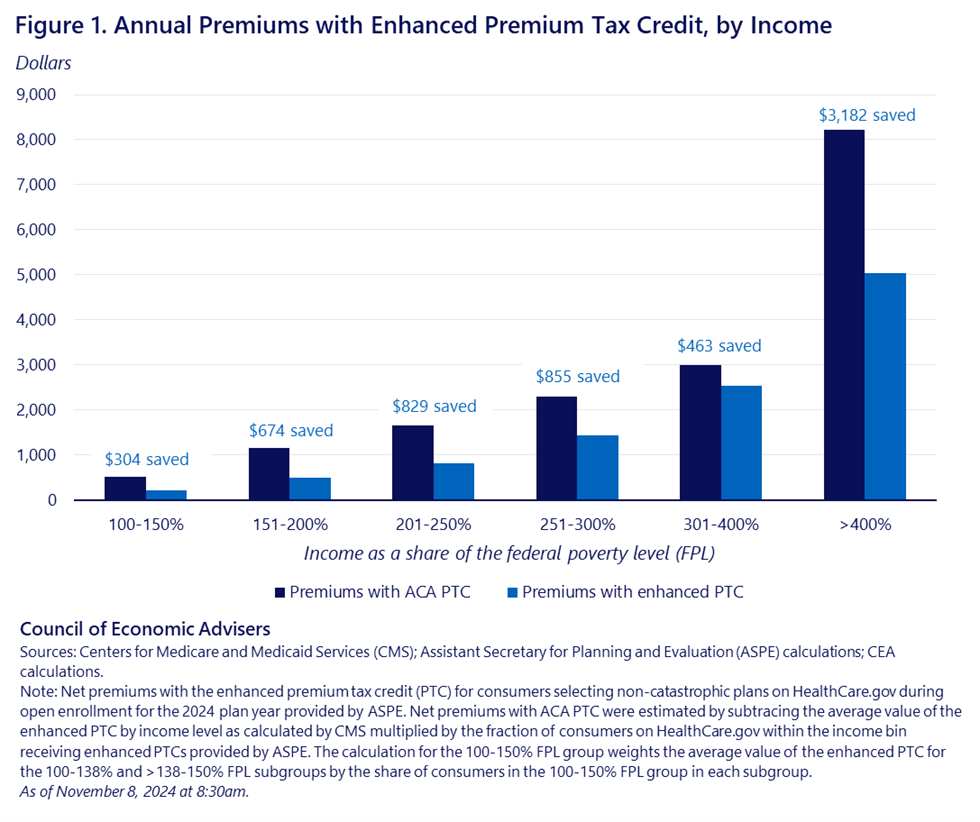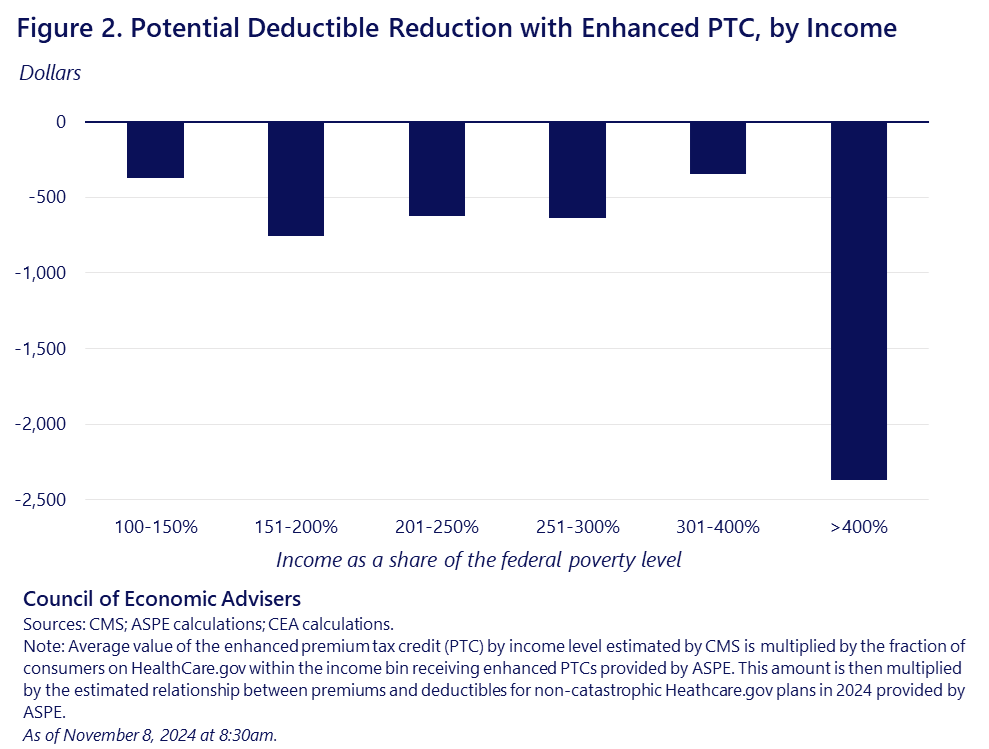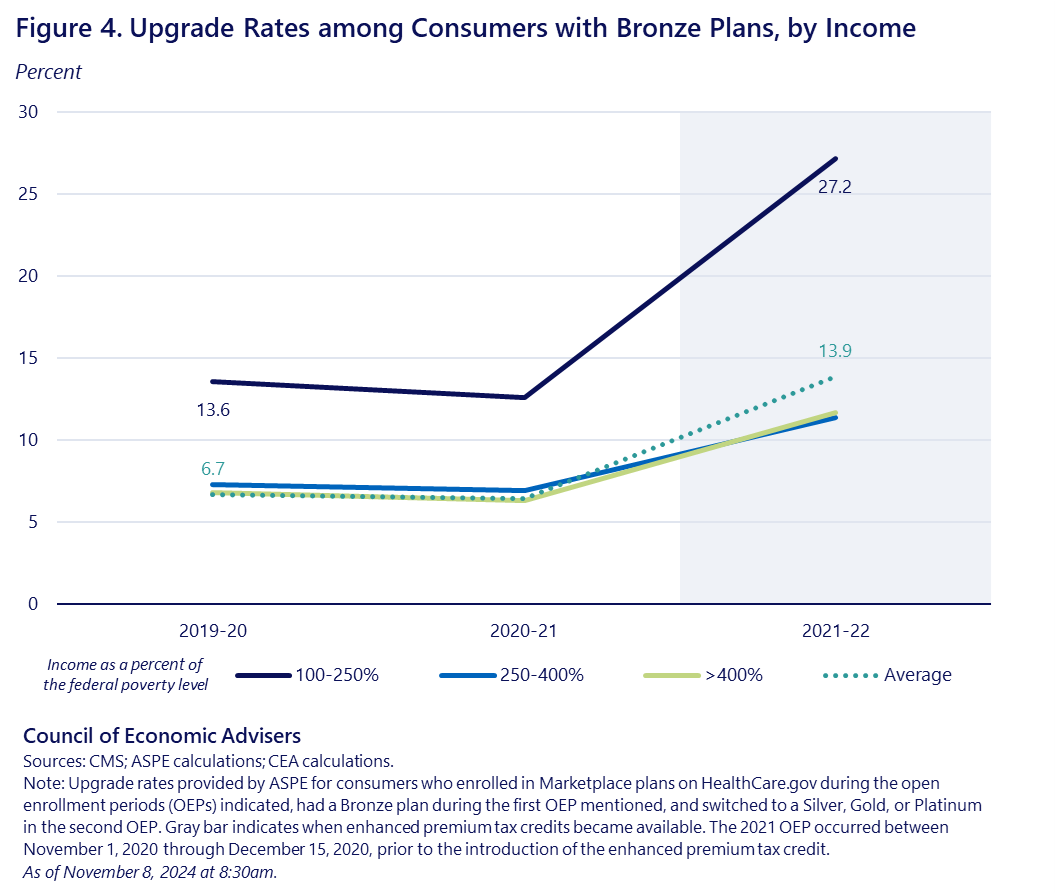Expanded Financial Assistance Allows Families to Save Money and Upgrade Health Insurance
The American Rescue Plan Act (ARP) expanded financial assistance for individuals and families to improve the affordability of health insurance coverage in the Affordable Care Act (ACA) Marketplace. Along with significantly increasing the premium tax credits for people already eligible for assistance under the ACA, the expansion, for the first time, reached people with incomes above 400 percent of the federal poverty level (FPL), effectively capping their expected premium contribution at 8.5 percent of annual income. Though these enhanced credits were set to expire at the end of 2022, the Inflation Reduction Act extended them through 2025. In this blog, we show how this policy significantly lowers the cost of health insurance to consumers, allowing more people to get covered, purchase insurance with better financial protection, and save money.
Since the ARP, nearly all consumers purchasing Marketplace coverage have benefited from the enhanced premium tax credits and saved on their premiums as a result. For the 2024 plan year, 92 percent of Marketplace consumers who signed up for coverage received these subsidies—approximately 19.7 million people. Figure 1 shows the average premiums for consumers on HealthCare.gov with the enhanced premium tax credits in 2024, as compared to what they would have been without the enhancement.[1] For consumers earning up to 400 percent FPL, the enhanced premium tax credit lowers the cost of insurance by approximately $300 to $860 for the year. Savings were larger for people with incomes greater than 400 percent FPL because these consumers were previously ineligible for premium tax credits. They now save an average of about $3,200 a year with this policy, after having their premiums capped. It is estimated that about half of the consumers receiving credits in this group have incomes between 400 and 500 percent FPL, or between $60,240 and $75,300 for a single person.

This benefit gives families the choice to pocket and use savings for other household needs, or to apply premium savings toward the purchase of a plan that offers more financial protection. Denoted by metal levels (Bronze, Silver, Gold, Platinum), plans with higher levels of coverage require lower cost-sharing by consumers and offer better financial protection against medical expenses. By reducing the cost of premiums, the enhanced premium tax credits make it easier for consumers to “upgrade” to a higher coverage plan.
Premium vs. Deductible Tradeoff
Higher coverage level plans improve financial protection in a number of ways, including lowering office copayments and reducing plan deductibles (the amount consumers pay before the insurance plan starts to pay). How much additional coverage do the enhanced premium tax credits allow consumers to buy?
We examine just one dimension of plan coverage—the annual deductible. We estimate how much consumers are typically able to lower their annual deductible by using their enhanced premium tax credit to purchase a plan with a lower deductible.[2] Figure 2 shows the estimated reduction in the annual deductible amount by household income. This amount ranges from around a $345 to $760 decrease for consumers with incomes below 400 percent FPL. Meanwhile, people with incomes above 400 percent FPL, who were not previously eligible for premium tax credits, could reduce their annual deductible amount by around $2,370.

Enrollment by Coverage Level
This policy is one of several that led to record-breaking Marketplace enrollment over the last three years. By lowering the cost of coverage, the enhanced premium tax credit allowed more consumers to afford coverage on the Marketplace and to purchase higher quality coverage. While enrollment increased for all levels of coverage, there was particularly large growth in the number of consumers signing up for coverage under Silver, Gold, and Platinum plans. These higher coverage level plans have low or moderate deductibles, in contrast to Bronze plans that typically have high deductibles and cost-sharing requirements. The greater affordability of higher-quality coverage with the enhanced premium tax credit may have led more consumers to determine it was worthwhile to purchase coverage.
As seen in Figure 3, the number of consumers signing up for Silver, Gold, and Platinum Marketplace plans for the 2024 plan year—at 14.7 million—is nearly double the 7.7 million who signed up during the 2021 plan year, just prior to the policy change. This growth in higher-level coverage enrollment is likely to increase the use of high-value health care and may have important implications for population health and future health care spending.

Upgrades among Existing Consumers
The growth in higher coverage plan enrollment reflects both new consumers entering the Marketplace, as well as improved coverage choices made by existing consumers who could either upgrade the coverage level of their plan, keep their coverage level but save money, or some combination of both. We find evidence that existing HealthCare.gov consumers were more likely to upgrade their plan from the Bronze coverage level during the first open enrollment period after the policy, as compared to upgrade rates during the open enrollment periods during the two years prior. The upgrade rate, defined as the share of consumers that remained in the Marketplace and switched to a higher metal level from Bronze, was particularly high for consumers with incomes below 250 percent FPL after the policy. Among this group, 27 percent switched from a Bronze to a higher coverage level plan from 2021 to 2022, a rate approximately 2 times higher than upgrade rates observed in the years prior (see Figure 4). Notably, consumers at this income level are eligible for additional cost-sharing reductions that are available in Silver but not Bronze plans. This suggests that the additional premium subsidies played an important role in assisting lower income Americans to purchase coverage that was designed to provide them with more affordable access to health care. Upgrade rates from Bronze also increased after the policy for other income groups, although their upgrade rates (both before and after the policy) are lower compared to the below 250 percent FPL group.

In conclusion, the enhanced premium tax credits enacted in 2021 and extended through 2025 have allowed more Americans to sign up for affordable health insurance coverage, save money, and increase the quality of their coverage. The Biden-Harris Administration has called on Congress to make these subsidies permanent.
[1] The analyses that follow exclude the 0.1 percent of consumers on HealthCare.gov who enrolled in a catastrophic health plan for the 2024 plan year. In addition, the analysis here does not consider potential savings on premiums that result from changes in who enrolls in Marketplace coverage with the enhanced premium tax credit. For instance, analyses by the Urban Institute suggest that, by attracting healthier people to the Marketplace and lowering the average health risk among those enrolled, the enhanced premium tax credit results in lower premiums even among those individuals who do not receive the subsidy directly.
[2] Using information on non-catastrophic plans on HealthCare.gov in 2024, we estimate the relationship between monthly premiums for the average age consumer and plan deductibles, adjusting for geographic rating area differences. We run the analysis separately by income bin to account for eligibility for additional cost-sharing reductions and exclude Gold and Platinum plans for income groups 200 percent FPL and below since the actuarial value for the Silver plans with cost-sharing reductions for these groups exceeds or is very similar to these higher coverage level plans. We find that each additional dollar in monthly premiums is associated with about a $9-$14 reduction in the annual deductible among plans, depending on the cost-sharing in the plan options offered across income groups. We next apply the estimated value of the enhanced premium tax credit to examine how much consumers are able to reduce their deductible if they apply this amount to a plan upgrade.
